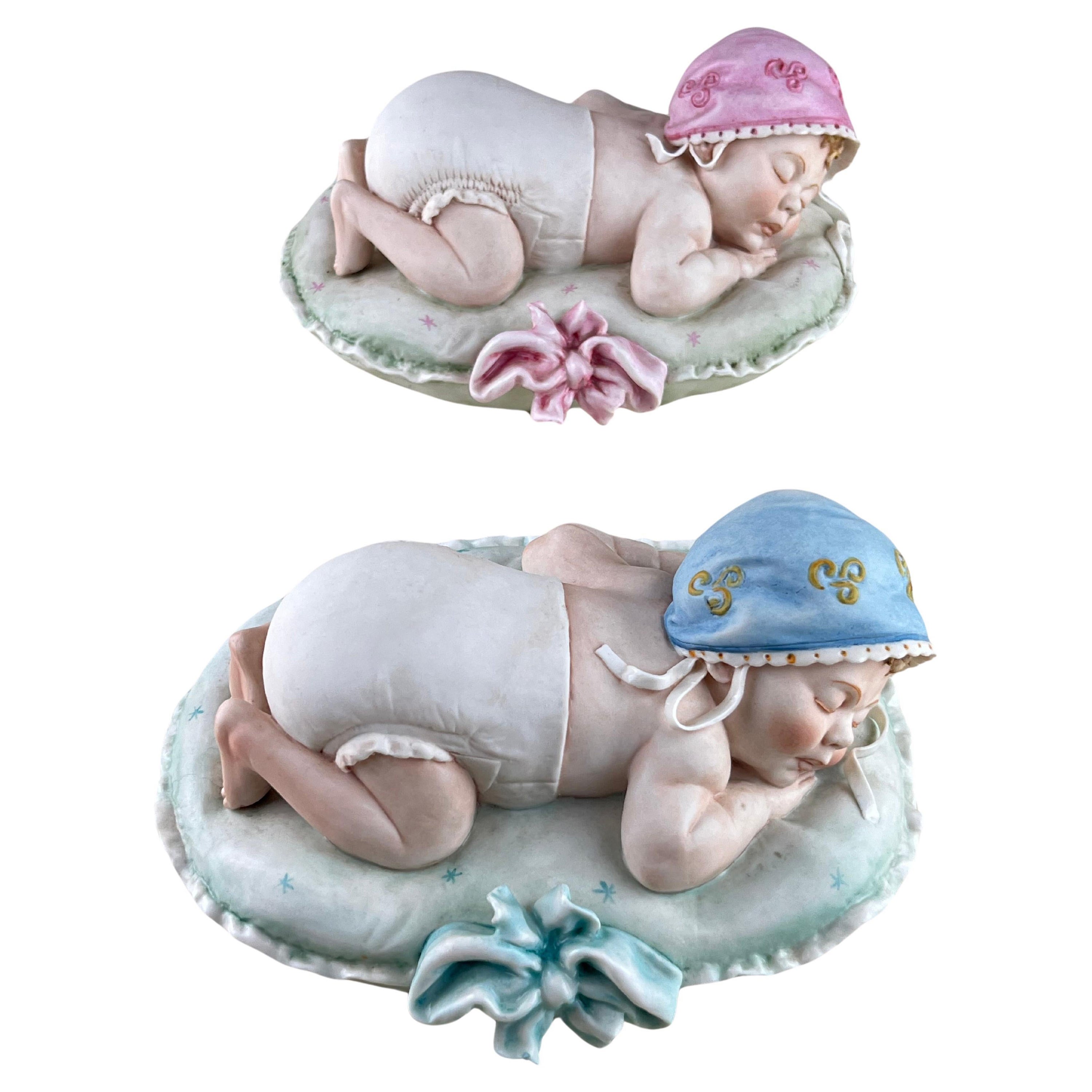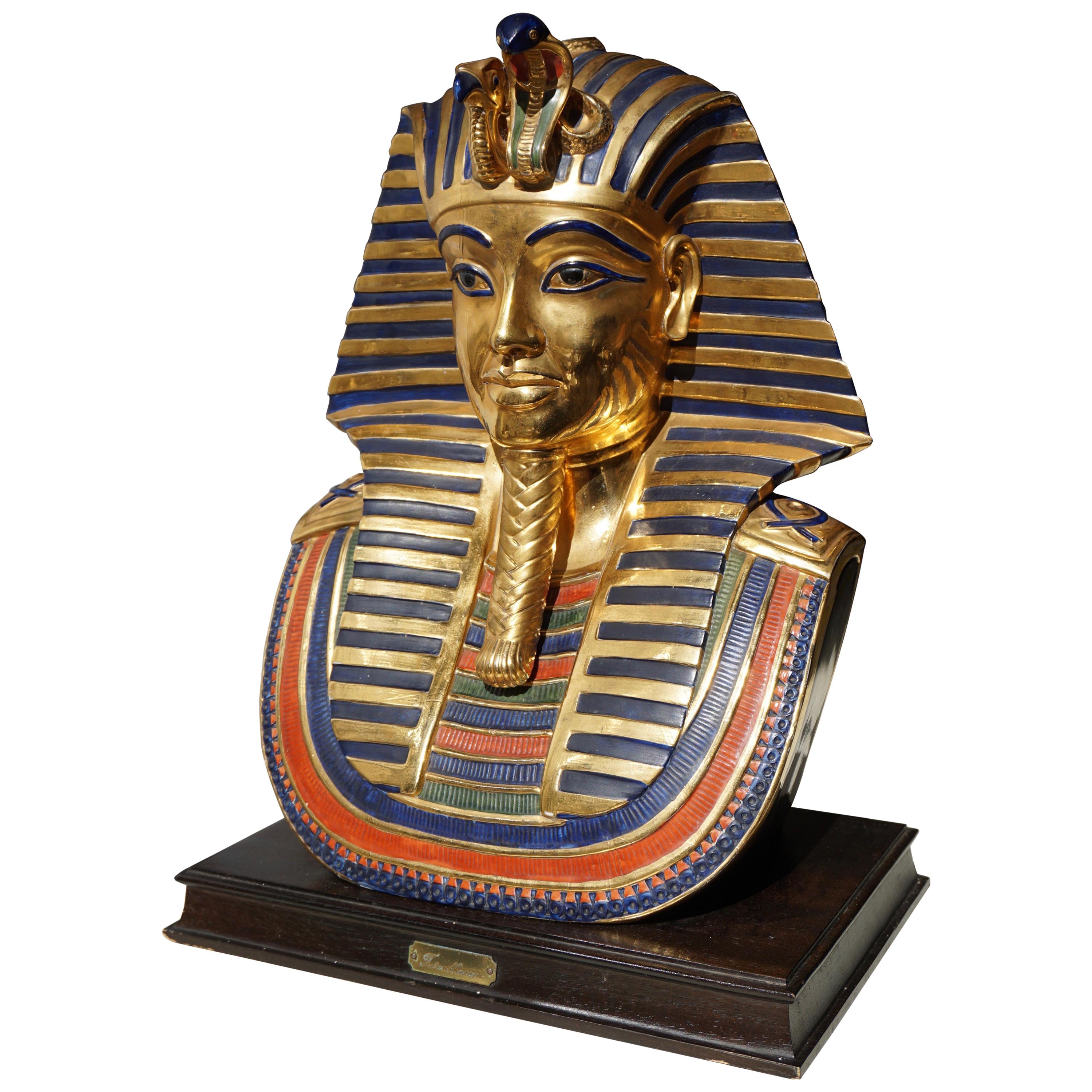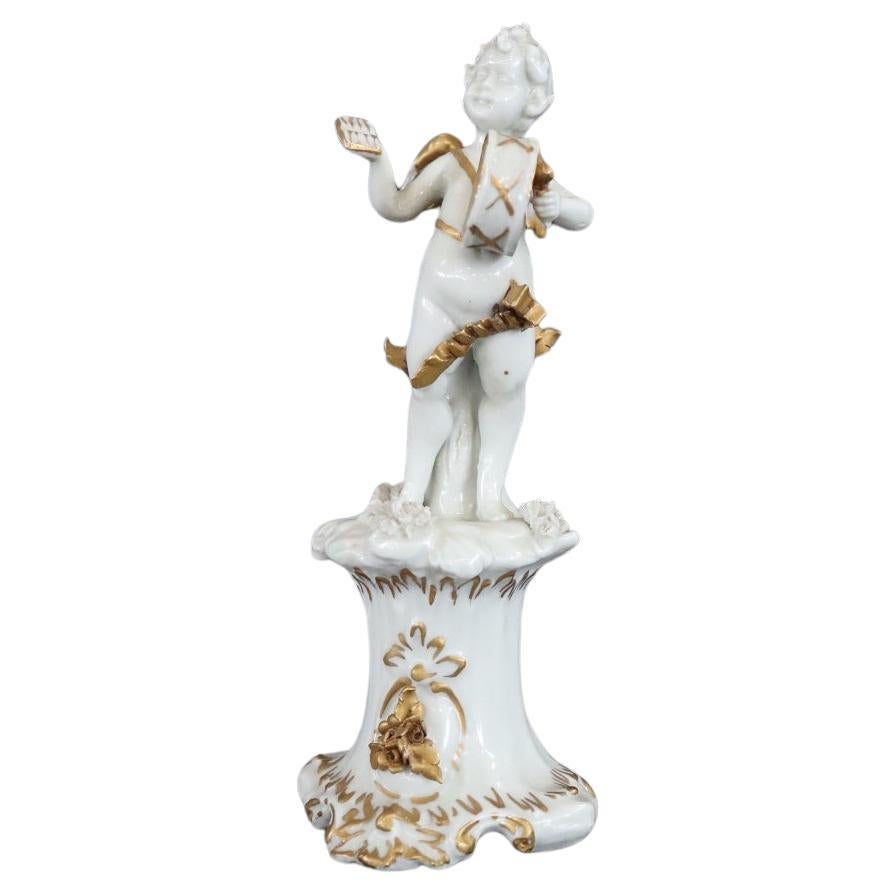Items Similar to Diana Of Versailles Pop Art Italian Reproduction In Capodimonte Porcelain
Want more images or videos?
Request additional images or videos from the seller
1 of 21
Diana Of Versailles Pop Art Italian Reproduction In Capodimonte Porcelain
About the Item
We kindly suggest that you read the whole description, as with it we try to give you detailed technical and historical information to guarantee the authenticity of our objects.
Particular and original porcelain reproduction in Pop Art style of the "Diana of Versailles"; the bust rests on a square black base also made of porcelain; the artifact was made between 2009 and 2010 in a craft workshop in Capodimonte, a hilly area of Naples (Italy). It was there in 1743 that King Charles of Bourbon and his wife Amalia of Saxony founded the Royal Factory of Capodimonte, dedicated to porcelain manufacture, within the palace of the same name. The idea of the sovereigns was to create precious objects on par with those produced by the German factory in Meissen, famous for its ceramics. The royals' wish was amply fulfilled because soon the Neapolitan porcelain tradition not only equaled the Teutonic tradition but, in all likelihood, surpassed it, resulting in true masterpieces. The porcelains of the Neapolitan Capodimonte tradition are distinguished by their distinctive milky color, greater firmness, and transparency, due to the absence of kaolin in the body, which is, therefore, composed of a fusion of clays from the quarries of the Mezzogiorno mixed with abundant feldspar. The bust is inspired by the statue of "Diana of Versailles" ", also known as "Diane de Gabies," which is a famous ancient marble statue depicting the goddess Artemis. It is believed to be a Roman copy of a Greek original from the 4th century BC. The sculpture is currently kept in the Louvre Museum in Paris, France. The original "Diana of Versailles" is a full-length statue, and there are no original half-length versions of the statue. The many reproductions and replicas of half-length Diana made over time are the product of the imagination of the many artisans who made them. The goddess Diana, called Artemis by the Greeks, is the daughter of Zeus and sister of Apollo. She is associated primarily with hunting, wilderness, childbirth, and virginity. Artemis is often depicted as a goddess of the hunt with a bow and arrow, accompanied by hunting dogs or deer. Artemis was revered by various cultures throughout the ancient world, and her mythology evolved over time. She was revered as the protector of young women and a guardian of wildlife. Artemis was also associated with the moon, often depicted with a crescent moon on her forehead. Pop Art emerged in the mid-1950s as a reaction against traditional notions of art. It celebrated the mundane, everyday objects and images of popular culture, elevating them to the status of high art. Artists such as Andy Warhol, Roy Lichtenstein, and Claes Oldenburg were key figures in the movement. Our Diana in its Pop Art style realization with vibrant and exuberant colors breaks away from classicism, while remaining in a pleasant and bold contemporary aestheticism that allows it to be placed with elegance and original sophistication in any type of decor. The object is in excellent condition. Measures width cm.29, depth cm.18, height cm.47. For all our shipments we use special packaging materials (custom-made wooden crates, styrofoam, etc.) for maximum protection and safety of the objects
- Dimensions:Height: 18.51 in (47 cm)Width: 11.42 in (29 cm)Depth: 7.09 in (18 cm)
- Style:Modern (Of the Period)
- Materials and Techniques:
- Place of Origin:
- Period:
- Date of Manufacture:2009-2010
- Condition:Wear consistent with age and use. The object is in excellent condition.
- Seller Location:Prato, IT
- Reference Number:
About the Seller
5.0
Gold Seller
These expertly vetted sellers are highly rated and consistently exceed customer expectations.
Established in 1977
1stDibs seller since 2019
236 sales on 1stDibs
Typical response time: <1 hour
- ShippingRetrieving quote...Ships From: PRATO, Italy
- Return PolicyA return for this item may be initiated within 14 days of delivery.
More From This SellerView All
- Art Deco French Sculpture of Two Fish in Craquelé PorcelainLocated in Prato, TuscanyWe kindly suggest you read the whole description, because with it we try to give you detailed technical and historical information to guarantee the authenticity of our objects. Nice ...Category
Mid-20th Century French Art Deco Animal Sculptures
MaterialsPorcelain
- Vintage Italian Head in White Glazed CeramicLocated in Prato, TuscanyWe kindly suggest you read the whole description, because with it we try to give you detailed technical and historical information to guarantee the authenticity of our objects. Orig...Category
Late 20th Century Italian Modern Busts
MaterialsCeramic
- Ruchot Jean Charles French Sculptor Art Noveau Statue of "Science" in SpelterBy Jean Charles RuchotLocated in Prato, TuscanyWe kindly suggest you read the whole description, because with it we try to give you detailed technical and historical information to guarantee the authenticity of our objects. Particular and elegant statue in spelter with marble base; the sculpture represents a young woman in a beautiful plastic and slender pose that holds in the left hand a laurel wreath and in the right hand a sheet of paper with an inscription, probably of scientific formula, in fact, the statue is the interpretation of "Science". The crown "triumphalis", precisely called "laurel crown", in Greek mythology symbolized wisdom and glory, it was the highest honor for a poet who had just graduated. Laurel was considered a sacred plant also by ancient Romans: it was venerated in particular by Apollo, god of the sun, music, poetry, sculpture, and painting. Precisely because of his countless knowledge, in fact, Apollo represented wisdom and intelligence. On the pedestal has been applied a scroll with the name of the sculpture itself and that of its author: Jean Charles Ruchot. It was made in spelter, with the technique of "lost wax", by the artist himself in his workshop in Romainville, a French commune located in the department of Seine-Saint-Denis, between 1900 and 1905. Jean Charles Ruchot, the refined and prolific artist, was active from 1890 until 1925, he produced classical works inspired by antiquity, then he was influenced by Art Nouveau, then by Art Deco, styles in which he expressed his greatest talent; he created many statues both in bronze and in spelter, he is also the author of many objects of decorative arts: lamps, sculptural groups for clocks and advertising objects. Spelter is a zinc-lead alloy that is aged to resemble bronze, but it is softer and can be easily melted and worked unlike bronze, composed of copper and tin, which melts between 850° and 1020°. Spelter has been used since 1860 to make objects that could compete with bronze, because of its great convenience and ease of use, this material had very strong dissemination and use when many sculptors and bronze Art Nouveau and Art Deco used...Category
Early 20th Century French Art Nouveau Figurative Sculptures
MaterialsSpelter
- Art Deco Saint Clement Style French Lion In Red Glazed Ceramic.By Saint-ClémentLocated in Prato, TuscanyWe kindly suggest that you read the entire description, as with it we try to give you detailed technical and historical information to guarantee the authenticity of our objects. Spec...Category
Vintage 1930s French Art Deco Animal Sculptures
MaterialsCeramic
- Art Deco French Ceramic Sain-Clement Statue Of Charles LemanceauBy Charles LemanceauLocated in Prato, TuscanyWe kindly suggest that you read the entire description, as with it we try to give you detailed technical and historical information to guarantee the authenticity of our objects Beau...Category
Early 20th Century French Art Deco Figurative Sculptures
MaterialsCeramic
- Art Nouveau Patinated Plaster of Paris Sculpture by Joseph Zomers BelgiumBy Joseph ZomersLocated in Prato, TuscanyWe kindly suggest you read the whole description, because with it we try to give you detailed technical and historical information to guarantee the authenticity of our objects. Statuette of a naked woman sitting in patinated plaster of Paris; plaster of Paris, is a very resistant material, used since ancient times, it was used by the ancient Egyptians as a binder in the construction of the pyramids and is used in sculpture for its strength, the name is linked to the ancient quarries of Montmartre in Paris; the statue is a work of the famous Belgian sculptor and bronze artist Joseph Zomers which he executed between 1915 and 1920 and whose signature is on the pedestal. The woman is represented posing with ill-concealed malice and shows without reticence her body with a thin erotic veil, the artist has not executed the face precisely to accentuate a mysterious charm; it is a figure of harmonic proportions that takes into greater consideration the erotic connotations, however, a refined and elegant eroticism that presents itself in a courteous manner, subtle and suggestive but at the same time provocative and irreverent; the woman, in her most intimate dimension, as a naked presence, defenseless but seductive, becomes the embodiment of the poetic essence of the artist, the emblematic figure of his aesthetics. It is an object in perfect Art Nouveau style (Jugendstil), in fact, many artists of this current used eroticism as their work, portraying women as ethereal and fatal beings, letting themselves be inspired by "le beau sexe" thanks to their naked forms, soft and seductive. Joseph Zomers was born in Liege in Belgium in 1895 and died in 1928; he studied art in Maredsous (Belgium), many of his works are permanently exhibited at the Musèe de Liège; Zomers is well known for his public monument "Tchantchès" in Liege. This great work in stone and bronze is located in the Otremeuse district in Rue Pont-Saint-Nicolas; designed by Joseph Zomers, the statue represents a "hiercheuse", the name was given to the women who pulled the carts in the mine, a tribute to those valiant young people vilified and victims of the exploitation of women's labor, the woman holds aloft the puppet of Tchantchès. Tchantchès is the name given to a puppet that appeared in Liège in the 19th century. The popular character, Tchantchès became over time the archetype of the goodman of Liege, witty and good-natured, wise and subtle, quick to find resolutions and fertile in resources, when he is depressed, he recovers with a joke that reveals the popular Walloon citizen, mocking and sentimental. It was therefore fitting to erect a monument to these two popular and significant symbols of the proud city...Category
Vintage 1910s Belgian Art Deco Figurative Sculptures
MaterialsPlaster
You May Also Like
- Plaster Bust of Diana of VersaillesLocated in New York, NYPlaster bust of Diana of Versailles, a statue of the Greek goddess Artemis.Category
20th Century Neoclassical Busts
MaterialsPlaster
- Italian Porcelain Set of 2 Figurines by CapodimonteBy CapodimonteLocated in Casale Monferrato, ITBeautiful set of 2 italian fine porcelain hand painting figurines by Capodimonte, circa 1990s. Brand present at the base. Two small defects, one of the boy's fingers and the girl's h...Category
1990s Italian Porcelain
MaterialsPorcelain
- Capodimonte Pharaoh Tutankhamon in PorcelainBy CapodimonteLocated in Antwerp, BEGreat sculpture representing Pharaoh TutanKhamon in Capodimonte Italia porcelain decorated and designed by Mario Pegorami is one of the most important artists representing the ancien...Category
Mid-20th Century Italian Mid-Century Modern Busts
MaterialsPorcelain, Wood
- Italian Porcelain Musician Angel by CapodimonteBy CapodimonteLocated in Casale Monferrato, ITBeautiful musician angel in fine porcelain by Capodimonte, circa 1980s. White color with golden details. Refined collectible ornament. Brand present at the base.Category
Vintage 1980s Italian Porcelain
MaterialsPorcelain
- Set of 2 Capodimonte Principe Porcelain "Sleeping children" Made in Italy 1980Located in Palermo, ITSet of 2 Capodimonte Principe porcelain "Sleeping children", Made in Italy, 1980s Pair of Capodimonte porcelain figurines from the famous Principe company. They date back to the 80s ...Category
Vintage 1980s Italian Figurative Sculptures
MaterialsPorcelain
- Napoleon Sculpture in Capodimonte Porcelain and Bronze, Italy, 1990sLocated in Palermo, ITMade in Italy, the work of one of the most renowned companies in the sector, the "Ticke" company. Intact, 37 cm high, has a bronze base. Worked entirely by hand.Category
1990s Italian Figurative Sculptures
MaterialsBronze
Recently Viewed
View AllMore Ways To Browse
Used Reproduction Furniture
From Versailles
Reproduction Sculpture
Versaille Furniture
Reproduction French Furniture
French Reproduction Furniture
Pop Art Furniture Italian Modern
Mid Century Modern Reproductions
1950s Reproduction
Made In Italy Statues
Italian Artifacts
Replica Italian
Replica Italy
Furniture Protectors
Zeus Italy
Women Statue
Women Statues
Dogs Of Paris





